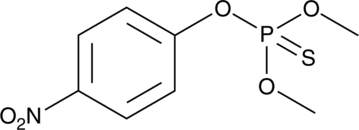Territorial Availability: Available through Bertin Technologies only in France
- Synonyms
- phosphorothioic acid, O,O-dimethyl O-(4-nitrophenyl) ester
- Correlated keywords
- 37359-35-6 63653-66-7 chlorochroa 8056HC Azofos Azophos Bravik 600CE Dalf Demethylfenitrothion 4 phosphorothionate 600 Folidol M 40 50 Folisuper 600BR ME 605 Mentox Meptox Metacide Metafos Metaphos Methion 605SP 48EC 1605 4E Bladan Methylthiophos Metron Morphos Nitrox 80 nitrophenyl thiophosphate Oleovofotox Paratuf Penncap MLS Probel MP 2 Quinophos Sinafid 48 Thiophenit Vofatox Wofatox Yphos bay11405 ME605 ME1605 ME605SP Metacid 600CE methylparathion MP2 M48 V-79 M40 M50
- Product Overview:
Methyl parathion is an organophosphate insecticide.{41949} It is converted into an oxon-containing metabolite in vivo, similar to other organophosphate pesticides, that inhibits acetylcholinesterase. Methyl parathion is lethal to lab strains and field isolates of tobacco budworm larvae (LD50s = 7 and 81.8-128.3 ?g/g, respectively).{45030} It reduces the number of stink bugs (C. sayi) caught per 100 net sweeps when applied to alfalfa fields at a concentration of 0.4 pounds per acre.{45031} Methyl parathion increases sister chromatid exchange (SCE) in a concentration-dependent manner and induces cell cycle arrest at the M1 phase in V79 cells at a concentration of 40 ?g/ml.{42227} It is toxic to rats (LD50 = 14 mg/kg).{41949}
Cayman Chemical’s mission is to help make research possible by supplying scientists worldwide with the basic research tools necessary for advancing human and animal health. Our utmost commitment to healthcare researchers is to offer the highest quality products with an affordable pricing policy.
Our scientists are experts in the synthesis, purification, and characterization of biochemicals ranging from small drug-like heterocycles to complex biolipids, fatty acids, and many others. We are also highly skilled in all aspects of assay and antibody development, protein expression, crystallization, and structure determination.
Over the past thirty years, Cayman developed a deep knowledge base in lipid biochemistry, including research involving the arachidonic acid cascade, inositol phosphates, and cannabinoids. This knowledge enabled the production of reagents of exceptional quality for cancer, oxidative injury, epigenetics, neuroscience, inflammation, metabolism, and many additional lines of research.
Our organic and analytical chemists specialize in the rapid development of manufacturing processes and analytical methods to carry out clinical and commercial GMP-API production. Pre-clinical drug discovery efforts are currently underway in the areas of bone restoration and repair, muscular dystrophy, oncology, and inflammation. A separate group of Ph.D.-level scientists are dedicated to offering Hit-to-Lead Discovery and Profiling Services for epigenetic targets. Our knowledgeable chemists can be contracted to perform complete sample analysis for analytes measured by the majority of our assays. We also offer a wide range of analytical services using LC-MS/MS, HPLC, GC, and many other techniques.
Accreditations
ISO/IEC 17025:2005
ISO Guide 34:2009
Cayman is a leader in the field of emerging drugs of abuse, providing high-purity Schedule I-V Controlled Substances to federally-licensed laboratories and qualified academic research institutions for forensic analyses. We are certified by ACLASS Accreditation Services with dual accreditation to ISO/IEC 17025:2005 and ISO Guide 34:2009.





